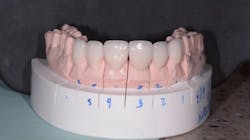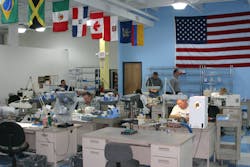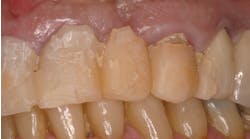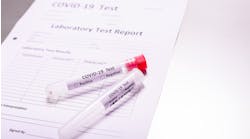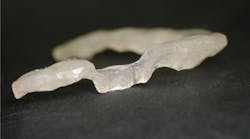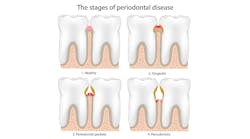Top 5 questions you should ask a lab before you send them a case
Before committing to a dental laboratory partnership, make sure you get answers to these important questions first. The entire process will work more smoothly, and you will be more satisfied with the results.
No. 1: “Do you use ADA-approved materials and genuine manufacturer parts and hardware for implant restorations?”
When choosing a lab, it is important to know what materials are used to produce the restoration. For example, what dental alloy does the lab use for cast restorations, such as porcelain-fused-to-metal (PFM) crowns and implant bridges? Base, noble, and high noble alloys are inherently different in price. Within these categories are many different formulations that can affect the total cost.
The amount of gold or palladium varies from alloy to alloy as well, and their market price changes daily. Base alloy is always much cheaper because it contains nonprecious alloys, such as cobalt-chromium (CoCr), nickel, or titanium. Noble alloys contain silver, palladium, small amounts of gold, and other trace alloys. High noble alloys contain gold, palladium, and trace alloys. Not only are alloys high-priced, but in the case of gold they are denser. The same casting in gold is heavier than it would be in other alloys. Due to the demand for platinum and palladium in the dental market and for catalytic converters, the price of palladium has skyrocketed. Depending on your school of thought as to which alloy is best, the price of a cast restoration can be much higher today.
If you choose a lab based on its low price, and they are quoting a low price for noble or high noble alloy, something is wrong. You cannot turn a blind eye to a lab that sells a high noble crown for $100. It is an impossibility. I’m not saying that base alloy is bad or that it should not be used; that is a choice for you to make. But if the lab misrepresents the base alloy as high noble, that is definitely an issue. If the lab explains the high alloy price to you and you are OK with either base alloy or CoCr, that is your prerogative. If the lab uses certified ADA alloys, they will have ident alloy stickers from the manufacturer to prove their authenticity.
The same goes with genuine manufacturer’s parts. If a genuine manufactured gold cylinder is $250, how could the crown be $300? It is up to the lab to be honest about the material it uses. If the lab uses a less expensive copy of the manufacturer’s parts and you are fine with that, then so be it. If they say the part is genuine but they’re actually using imitation parts, they are not being honest with you. If you choose to go this route, just don’t blame the lab.
In the case of brand-name crowns, such as the many different all-ceramic restorative options on the market, you will want to know if the lab is an authorized lab for that product and if they are using genuine material. For example, is the crown you received a genuine e.max or BruxZir crown, or is it an imitation? There are zirconia and zirconia disilicate materials that cost a fraction of the price, yet they are being passed off as the real thing. I get emails almost daily for cheap zirconia from overseas that costs pennies to the dollar compared to materials from established manufacturers. Personally, I would rather use the material from an established company than an imitation with no research or representation to back it up. Always remember, if the lab is offering you a product at a much lower price than every other lab is for the same thing, chances are it is not the same thing.
No. 2: “Are you digital?”
This is a vital question in the 21st century. How could a lab not be digital? But many are not. That is not necessarily a bad thing, but how can a lab offer modern milled restorations without the CAD equipment? If the lab owner is planning to retire in the near future, there is no reason for the lab to go digital. The lab can ride along using the traditional methods until the end. Some are simply stubborn disbelievers of the digital world, and the same goes for many dentists. They like the traditional crown and bridge, but labs need to be able to deliver what customers want.
Why is this an important question? Converting to digital for the dentist is hard work, so help from the lab is important. Lab techs and owners can guide dentists in everything from purchasing equipment to maintenance to training. The lab is a crucial component to the dentist-lab partnership. An experienced lab is an absolute necessity to produce the correct final restorations as it has a relationship with the manufacturers of the machinery and suppliers of the required materials. The lab also has connections to the best technical support, and the tips and tricks for making things work.
It is wise to ask the lab what system they recommend. For instance, when an inexperienced dentist buys a scanner, there is a learning curve of a few months on how to get the best impressions, etc. The lab can advise and train the dentists to make things go more smoothly. An experienced dentist needs assurance that the lab can get the job done right. If the technician does not know what a .stl is, then it’s time to find another lab.
The same goes for things such as scan bodies for implants. It’s best to ask the lab which ones are best to buy or even get them from the lab, since the lab probably has a preference. Technicians can tell you which scan body works best for them for better results. To attend a conference and without question follow the protocol of the speaker whose lab does not follow the same protocol is counterproductive. The speaker may be paid to promote a product. The lab you choose to work with must have the knowledge and experience to give you what you want. Forcing them to buy material and follow techniques that are foreign to them will result in nothing but problems.
No. 3: “Do you ‘offshore’ your work?”
Most people use the term outsource. Sending impressions to a lab is outsourcing. When a small lab that only does crown and bridge needs to have another lab make something like a steel partial, that’s also outsourcing. Using a milling facility to mill custom abutments or frames is outsourcing. Sending impressions to a lab to make crowns is outsourcing.
Offshoring is outsourcing to other countries to get the same work done that the lab could do but at cheaper prices. Offshoring is an issue across the whole country; countless industries have been affected or destroyed by the desire to have work done cheaper overseas. In the last 20 years, it has become very profitable for investors to open a storefront that just sends your cases overseas. It is virtually impossible for a US lab to offer a crown in the same price range. The cost of labor overseas is a fraction of what it is in the US—not to mention the human rights of those who work for pennies in foreign countries.
If you are comfortable with a $29 crown from an overseas lab, that is your decision. But don’t be deceived into thinking the work with that low price is made in the US. As a dentist with considerable overhead and expenses, you have to know and understand that. The cost of materials and labor is 90% of the crown. The profit margin for most labs is quite low. Asking a lab to match the price structure of an offshore lab is not fair to the lab. There is no way they would be able to compete. This is a perfect example of comparing apples and oranges. The lab work is similar only in name—without the same practices and quality. This is the same type of complaint I’ve heard from dentists about corporate dentists.
No. 4: “Are you a DSO?”
Why is this important? It’s actually not. What is important is to know who you are working with. Are you talking to a salesperson? A technician? The lab owner? A shipping person? With the growth of DSOs for both labs and dentists, how you communicate with each other is critical. Knowing how the system works makes life easier. Is the lab invested in the success of the work? Do the technicians care about the growth of their relationship with the dentist? What is their expertise? Are there managers in each department of the lab? Who will be speaking to you and handling your account? One thing I know about dentists is that they like consistency and direct communication. Being shuffled around by many different people and having the feeling of being just a cog in the machine is not desirable.
You should have a name for all of the individuals who will aid you in pick up, delivery, and scheduling at the lab. You should also have a contact point for consulting on frame design and procedures. You should know who to talk to about quality control and preferences. And you should have access to someone with whom you can discuss payments and problems, should they arise.
No. 5: “May I inspect your lab?”
It is nice to meet the owner or manager, the quality control person, and the front office people so you’ll have faces to attach to the voices you’ll speak to. A tour of the lab will let you know if all of the work is done on the premises or offshore. If the lab has shelves filled with empty pans, where are the cases? Chances are they are overseas. What you are looking for is whether the lab is being truthful with you. Did they feed you a sales pitch and now you are finding out the reality with that lab? Is this really the lab you want to work with?
The modern dental lab is a sleek, neat, professional business establishment. The days of filthy walls and floors covered in dirt and pumice are over. How are the technicians dressed? If they do not take pride in their appearance, how could they take pride in their work? Is the lab equipped with a proper shade room for patients to visit? Is the lab HIPAA- and OSHA-compliant?
It is a mistake to find a new lab and immediately send in all of your work that same day. You need to court each other for a while. Send one case at a time, perhaps five in the first month. No two people—lab tech or dentist—are the same. We all have our own personalities and desires. The lab needs to learn your preferences to be able to give you consistent work. By going slowly, the lab techs can get feedback from you one case at a time until they understand what you want. I have had dentists who have requested 1 mm shy occlusal contact, no interproximal contacts, 150 micron relief for a loose-fitting crown, no die spacer at all, lingual vent holes, and many other specifics.
The other part of the courtship involves personalities. Sometimes they just clash. Remember, this is a partnership. Neither person should be condescending to the other, and both should treat each other with respect. Writing in all caps on an Rx is, in essence, yelling and will not be well-received by the lab. You may find in a few months that the work and the way you react to each other just isn’t working. A mutual separation is the most responsible way to move forward. It’s a small industry, so one day you may meet up again at a dental meeting or seminar or even a restaurant. It’s better to be able to say hello than hide.
Plus, why are you leaving your lab? If you have a long-standing relationship with them and things start going bad, discuss your concerns with the lab owner and give them a chance to fix it. We are all in the same world trying to make a buck and do quality work, but we are all victims of manufacturers, products, and labor. A bad batch of any material, from zirconia to investment to impression material, can result in remakes. Working together you can fix the problem. It takes time—sometimes a few months—before you’ll begin to see the improvements.
If you do intend to leave your current lab, start sending your work to the new lab and slowly let the old lab finish what they started. Never ask a new lab to finish the old lab’s work. Under no circumstance should you just disappear and not pay the bill. That is only asking for trouble. Even if leaving the lab is a necessity, not paying them makes you the bad person. You are now the one who stiffed the lab. They still did the work and paid their employees, so the least you could do is call the lab and try to arrange a settlement fee. It is best to end on good terms. You may need your old lab to repair one of the new lab’s cases in the future. Your former lab may even improve so that you want to go back. They may get bought by a DSO that you want to work for. Whatever the case, you don’t want to burn any bridges.
After you have asked all of these questions and finished your courtship with the lab, you should be ready to begin a long relationship with each other. In some cases, your lab partner will be around longer than your life partner!
Editor’s note: This article originally appeared in Perio-Implant Advisory, a chairside resource for dentists and hygienists that focuses on periodontal- and implant-related issues. Perio-Implant Advisory is part of the Dental Economics and DentistryIQ network. To read more articles, visit perioimplantadvisory.com and subscribe at this link.
